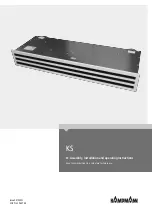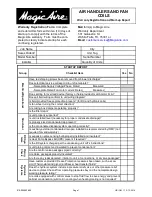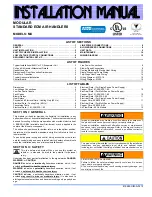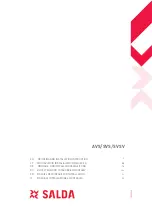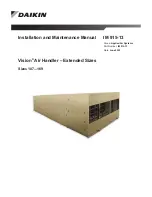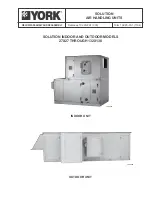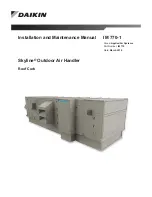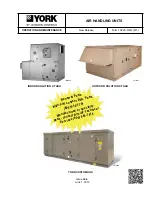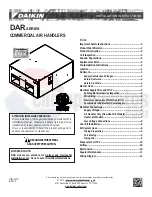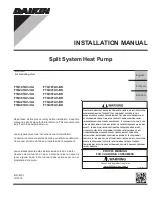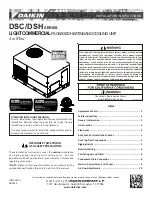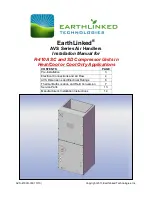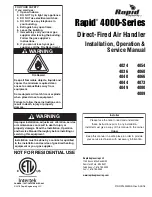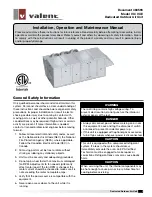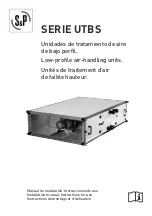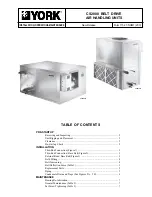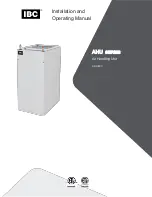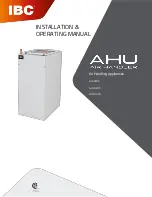
5169032-UIM-C-0416
Johnson Controls Unitary Products
5
4.
Note the numbered position of the coil slide rail located at the upper
right hand side of the indoor coil compartment. Remove slide rail
from air handler cabinet by removing front screw and lowering
bracket down to disengage hook on back of slide rail.
5.
Turn air handler cabinet upside down (downflow position).
6.
Install coil slide rail by hooking the aft end into holes at the num-
bered position the slide rail was originally in right rear corner post,
and secure rail into right front edge of cabinet with screw in the pre-
drilled hole.
7.
Install center support bar for the coil/drain pan onto the lettered
position that it was originally mounted.
8. For horizontal right applications, the front and back coil blow off
wings must be installed (blow off wings are shipped with the unit).
Locate 4 screws securing coil delta plates to coil drain pan. Loosen
the screws. Slide each coil blow off wing between the drain pan and
the coil delta plate. Tighten screws to secure coil blow off wings.
Refer to Figure 5.
9.
Slide the coil back into the cabinet. Be sure to engage the side coil
slide into the slide rail on the air handler cabinet.
10. Install coil access panel. Conversion is now complete.
SECTION IV: DUCT WORK AND
CONNECTIONS
Air supply and return may be handled in one of several ways best
suited to the installation. Upflow, horizontal or downflow applications
may be used.
The vast majority of problems encountered with heating and cooling
systems can be linked to improperly designed or installed duct systems.
It is therefore highly important to the success of an installation that the
duct system be properly designed and installed.
When installing a central air return grille in or near the living space, it is
advisable to design the duct work so that the grille is not in direct line
with the opening in the unit. One or two elbows and acoustical duct liner
assures a quieter system. Operation where return air duct is short or
where sound may be a problem, acoustical duct liner should be used
inside the duct. Use flexible duct connectors to minimize the
transmission of vibration/noise into the conditioned space.
Insulation of duct work is a must where it runs through an unheated
space during the heating season or through an uncooled space during
the cooling season. The use of a vapor barrier is recommended to
prevent absorption of moisture from the surrounding air into the
insulation.
The supply air duct should be properly sized by use of a transition to
match unit opening. All ducts should be suspended using flexible
hangers and never fastened directly to the structure.
Duct work should be fabricated and installed in accordance with local
and/or national codes. This includes the standards of the National Fire
Protection Association for Installation of Air-Conditioning and
Ventilating Systems, NFPA No. 90B. If electric heat is used, non-
flammable material must be used. Duct systems should be designed in
accordance with the Air Conditioning Contractors of America (ACCA) –
Manual D.
NOTICE
The position identifier for the coil slide rail is embossed into the back
corner vertical angle of the cabinet structure. There are four position
identifiers: 1, 2, 3, or 4. The numbered attachment location can differ
from unit to unit due to the cabinet height of the air handler. After
removal and reinstallation, the coil slide rail must be installed in the
same numbered position that it was originally.
NOTICE
The aft fingers of the center support bar are longer than the fingers on
the forward end of the support bar.
FIGURE 5:
Coil Blow Off Wing Installation
I
nsta
ll co
i
l blow o
ff
w
ing
o
n
fr
o
nt
and
b
a
ck o
f
co
i
l.
CO
IL
DELTA PLATE
DRAIN PAN
SC
REW
S
BL
O
W
O
FF WING
A
0
4
1
7-
001
(2 p
er
blow o
ff
w
ing
)
WARNING
Do not bring in return air from a location which could introduce haz-
ardous substances into the airflow.
Use 1/2” screws to connect duct work to cabinet. If pilot holes are
drilled, drill only through field duct and unit flange.
CAUTION
This unit is not designed for non-ducted (freeblow) applications. Do
not operate without duct work attached to unit.
Equipment should never be operated without filters.
!
!





















